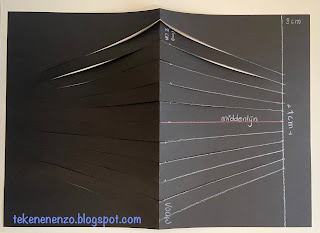Victor Vasarely, 1906-1997, was a French-Hungarian artist and one of the most important representives of Op Art. Vasarely studied in Budapest and left for Paris in 1930 to work as a decorator.
Op-art, short for optical art. The word optical is used to describe tings that relate to how we see. Artists use shapes, colours and patterns in special ways to create images that look as if they are moving or blurring. Op art started in the 1960. Op-art is a style of visual art that uses optical illusions. The artwork gives the viewer the impression of movement, hidden images and vibrating patterns.
You need:
- black construction sheet (23 by 33 cm,)
- white or colored paper in strips of 2 cm
- ruler
- pencil
- scissors
- glue
Stap 2
Leave the sheet folded in half. Cut the lines up to the 3 cm strip.
Weave the strips into the frame. Start in the middle: press the strips agaiinst the fold on both sides. Press the next strips against the previous ones. Stap 4
Glue the loose ends on one site.
Stap 5


























